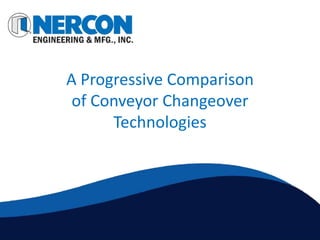A Progressive Comparison
- 1. A Progressive Comparison of Conveyor Changeover Technologies
- 2. Cost versus Man Hours This is the baseline 100 Feet of Straight Conveyor $30 / hour Labor Rate 250 Changeovers Per Year
- 3. Cost versus Man Hours Note set points on each comparison 100 Feet of Straight Conveyor $30 / hour Labor Rate 250 Changeovers Per Year Set Points
- 4. Standard: Baseline BASELINE 108 Adjustment Points $7,500 in labor 60 Min. 250 hrs. lost/year
- 5. Ratchet Handles / Manual Adjustment Level 1: RATCHET HANDLE 108 Adjustment Points $5,625 in labor 45 Min. $1,000 for the 188 Hrs. ratchet Lost/Yr. handles
- 6. Ratchet Handles with Set Points Level 2: RATCHET HANDLE With Pre-Measured Points 108 Adjustment Points $3,750 in labor 30 Min. $2,000 for the ratchet handles and 125 Hrs. pre-measured set points Lost/Yr.
- 7. Ratchet Handles with Set Points on One Side Level 3: RATCHET HANDLE one side 54 Adjustment Points $1,875 in labor 15 Min. $1,500 for the ratchet handles and 62 Hrs. pre-measured set points Lost/Yr.
- 8. Hand Wheel Indicator Level 4: HAND WHEEL DIAL INDICATOR One Side 3 Adjustment Points $625 in labor 5 Min. 20 Hrs. $22,500 for rail system Lost/Yr.
- 9. Automatic Guide Rail Adjustment Level 5: AUTOMATIC ADJUSTABLE With Operator Push Button Station 1 Adjustment Point $125 in labor 1 Min. 4 hrs. $27,500 for rail system Lost/Yr.
- 10. Changeover White Paper Click here for White Paper
- 11. Cost versus Man Hours 10 YEAR Labor Cost Versus Purchase Cost 80000 BASE 70000 60000 MANUAL 50000 SET POINTS COST $ 40000 COST AUTO- LABOR 30000 HAND MATIC WHEEL 20000 ONE SIDE 10000 0 1 2 3 4 5 6 CHANGEOVER SOLUTIONS Manual Automatic
- 12. Thank you for your time! For more information, videos, webinars and white papers, visit our website www.nercon.com ŌĆó Sign up for Knowledge Center Check out our blog!
Editor's Notes
- #3: Now, weŌĆÖre going to talk about purchase cost of the solution compared to the man hours to make the changeover and the lost production time. Here is the assumptions in the analysis ŌĆō which is also highlighted in our white paper download that we send as a follow -up:A 100 foot straight conveyor sectionA $30/hour labor rate250 Changeovers per year
- #4: Beginning with the baseline (which is all manual adjustment) to fully automatic solutions, Dennis Buehring is going to walk us through his comparison which will includes top-view drawings on each slide to illustrate the set pointsŌĆ”Dennis?
- #5: Thank you, Jessica: The baseline calls out manual, slotted brackets with carriage bolts.In 100 feet, there are 108 adjustment points ŌĆōThatŌĆÖs 60 minutes to changeover and one hour of lost production time.Of course this is the baseline and there has been no changeover upgrades, so there is no cost investment beyond the conveyors.At 250 changeover events per year, the labor costs $7,500 and with 250 hours of lost production time per year.
- #6: For Level 1, we are upgrading to ratchet handles with an additional cost of $1,000.Ratchet handle make the adjustments faster, so we just saved 15 minutes of lost production time per changeover.At 250 changeovers per year, the labor costs are $5,625 and 188 hours of lost production time per year.
- #7: Now add pre-measured set points like in the photo. There is no measurement required for guide rails position.Ratchet handles and pre-measured set points make it even easier to adjust guide rails, so we just saved ┬Į hour of lost production time per changeover compared to the base conveyor.At the same 250 changeover events per year, the labor costs are lowered to $3,750 with 125 hours of lost production time per year.
- #8: Now take this same example with ratchet handles and pre-measured set points and keep it to one side of the conveyor.With set points being cut in half, we reduce changeover time to 15 minutes.
- #9: On Level 4, we are upgrading to a hand wheel with a dial indicator on one side of the conveyor. This option lowers your adjustment points on this example to just three. These 3 points typically are located on one side of the conveyor with dial indicators.Though the hand wheels are all located on the same side of the conveyor, your product remains centered due to the hand wheel being connected via right and left handed threads.The added investment for a this option on hundred feet is about $22,000.But with changeover costs reduced to $625 in labor and only 20 hours of lost production time per year, the Return on Investment is 3 years in this example.
- #10: On Level 5, weŌĆÖre using the example of a fully automated system with an operator push button station. The additional investment for a hundred feet is about $27,500.There are only 1 adjustment point ŌĆōChangeover is 1 minutes.At 250 changeovers per year, the labor costs are reduced to $125 and 4 hours of lost production time per year. The return on investment for this solution is almost 4 years.JESSICA -- Thank you Dennis ŌĆō As mentioned earlier, this comparison is available in our new white paper.
- #11: Everyone attending today will receive the download link to ŌĆ£Changeover Technology That Saves Time.ŌĆØAnd you can review this analysis on the inside center spread of the publication.
- #12: To Recap and Look at DennisŌĆÖ results in a different way we have this chart that represents costs over 10 years.The red bars represent labor costs and the blue bars represent purchase costs.In every one of DennisŌĆÖ examples, time was taken off the clock. And as you can see from the hand wheel and automatic technology that changeover time is quite minimal.And time is money ŌĆō it is lost production that really adds up which isnŌĆÖt on this chart ŌĆō thatŌĆÖs the part that you need to calculate. If one changeover takes one hour, what is the cost revenue from just one hour of lost production? Take that times the number of changeovers in a day or a year and it is the lost production that adds up.Our ROI examples were based off of labor, but depending on your business, if you use lost revenue in your ROI calculation you might be able to get your ROI from a few years to a few months. Thank you for your time today, now IŌĆÖll turn it over to Joyce Fassel who will moderate your final questions.

















































